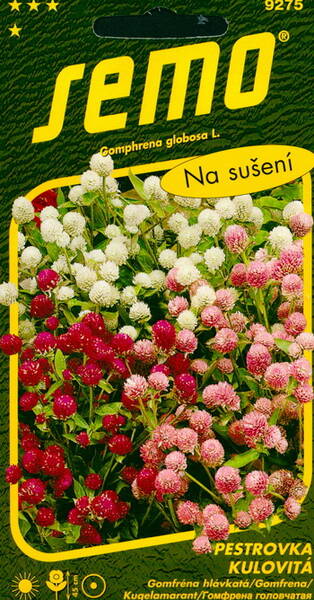It looks spectacular in winter bouquets, retaining its colour perfectly!
An annual, highly branched plant, 45-60 cm tall.
The stems and fairly large leaves are covered with fine gray hairs. The inflorescences are terminal, spherical or oblong, reminiscent of those of red clover.
The flowers in the inflorescences are small, purple, and almost invisible. The membranous bracts, brightly colored in shades of white, cream, pink, crimson, red, and purple, give the inflorescence its rich color.
Prefers sunny areas, light, moderately moist soils. If there is an excess of organic fertilizers, gomphrena may not bloom .
Seeds are sown for seedlings in early April. The seedlings, which emerge within 1.5–2 weeks, are transplanted into pots and planted in the ground at a distance of 30 cm in early June.
Used for making winter bouquets and in flower beds.
1,0 g = 200 seeds.
* Gomphrena globosa L.
Homeland: tropical America.
An annual plant belonging to the dried flower group. It forms highly branched bushes up to 35 cm tall, reaching 70 cm in southern regions. The leaves are short-petioled, elongated-elliptical, with entire margins and a glaucous tint due to ptosis. The flowers are small, carnation-shaped, with membranous bracts of white, pink, or purple, gathered in elongated-oval, capitate inflorescences up to 3-4 cm in diameter, located at the ends of stems, sometimes on lateral shoots emerging from the leaf axils. In Estonia, the seeds ripen only on the main shoot.
In cultivation since 1714.
A less common dwarf form (f. nana compacta) grows up to 15 cm tall, with white or red inflorescences. One gram contains approximately 800 seeds.
Gomphrena globulosa seeds are sold mainly in the form of various color mixtures.
Location: Since gomphrenes originate from the tropics, they require a sunny, warm location.
Soil : grows well only in loose and nutritious soil.
Care: Cultivation techniques are similar to those for celosia and variegated amaranth. Fertilizers should be applied very sparingly; too much organic fertilizer may prevent flowering . Fertilize with a complete fertilizer only during seedling growth and for the first month after planting; stop feeding once flowering begins.
Propagation: sow seeds in boxes in March. Seedlings emerge in 14-16 days. After 1.5-2 weeks, transplant them into 7-8 cm diameter pots, boxes, or greenhouse beds. Gomphrena transplants very well . Transplant seedlings in early June, spacing them about 25 cm apart; for dwarf varieties, 15 cm.
Uses: in flowerbeds, borders, and edgings, as a potted plant. They are very effective in winter bouquets, as the dried flowers retain their color and shape well. In our climate, good flowering of gomphrena is not seen every year. In cold, rainy summers, plants can suffer from excess moisture and insufficient heat, so if you want high-quality cut flowers, it is best to grow them in a greenhouse.
But in warm summers, gomphrena thrives in open ground and can be successfully used to decorate borders, flower beds, rock gardens, and also grown in pots and containers.
For drying, gomphrena shoots are cut at a time when the inflorescences have reached their maximum size, but the lower scales have not yet begun to turn brown.
After cutting the shoots, new flower stalks begin to grow quickly in the axils of the leaves located on the stem below the cut.
Gomphrena is dried by tying several shoots into small bundles and hanging them in a dry, darkened room.
Eng.: Common globe amaranth, bachelor's button, globe amaranth.












